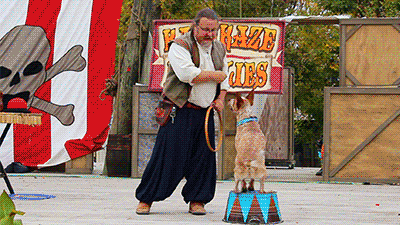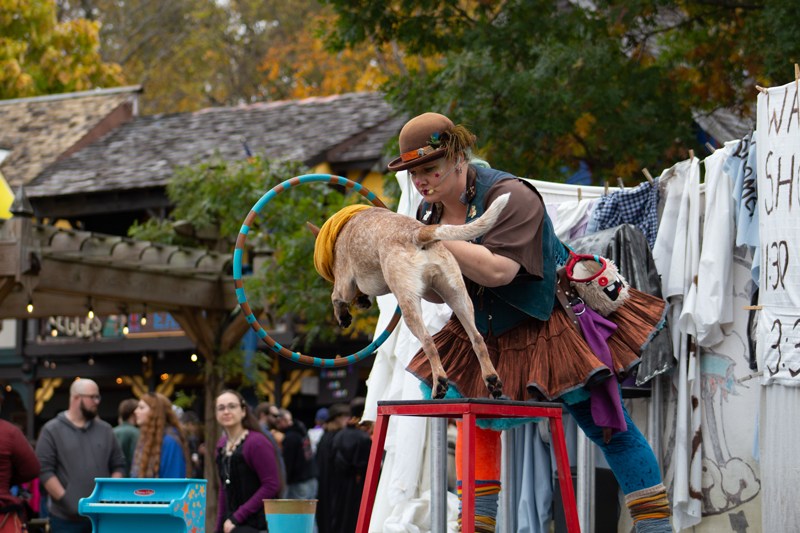Wel folowing his maistre and doyng whatever he hym commandeth, he shuld be good and kyndly and clene, glad and joyful and playeng, wel willyng and goodly to all maner folkes save to the wild beestis.
14th century quote as to the mannerisms expected of dogs
In the Elizabethan world as well as modern times, dogs have had a place by their owner’s side. Their love and devotion, sense of playfulness, and intelligence have made them ideal companions for much of human history. For many folks, the idea of going through life without a dog’s head to pat is nigh inconceivable. For the Elizabethans, it was no different. Dogs were companions, guards, hunters, and amusements for their owners, and some were adored just as fervently as our family animals today.
Working Dogs
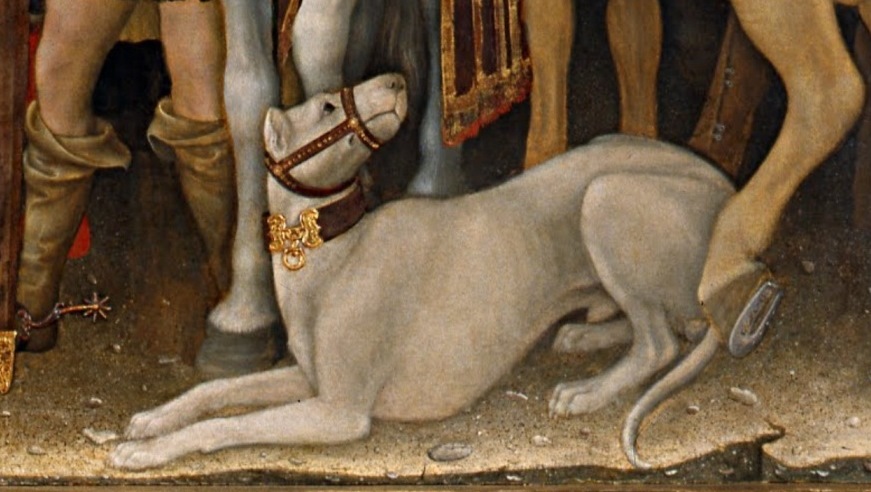
The hound of the average fellow was less a pet and more a fellow worker who had to earn its room and board. Watchdogs, such as mastiffs, were often employed as effective guards who patrolled their master’s property and alerted them to intruders or predators. The alaunt gentil, a bulky dog with the frame of a greyhound, was a proficient herding breed mostly utilized with cattle as they had a reputation for being ferocious enough to handle an angry bull. Shepherds and the like also kept herding dogs, which served often as guards and companions for the family. Terriers were highly prized among the common folk, given their skill and voraciousness as ratters, which kept these excitable creatures well-employed.
There was even something known as a Kitchen Dog, or a Turnspit Dog, whose entire job was to run on a wooden wheel that turned the roasting spit over the fire so the meat would cook evenly. The only requirement for this ‘breed’ was that they have short legs and be sturdy enough to keep going until the meal was ready.
Hunting Dogs
Hunting was one of the favorite sports for those with the land and means to participate in. Hunting dogs were considered prized animals, trained meticulously, and cared for as symbols of wealth and status. Running hounds were used to scent and track prey, while gazehounds were prized for their ability to quietly stalk prey and then utilize their speed to take it down. Scent hounds, wolfhounds, and greyhounds, for the most part, were valued for their powerful noses and for tracking prey by their smell. A lymer, or bloodhound, was a special selection of hunting dogs that were trained to locate droppings and follow them to where the animal was resting before the hunt began.
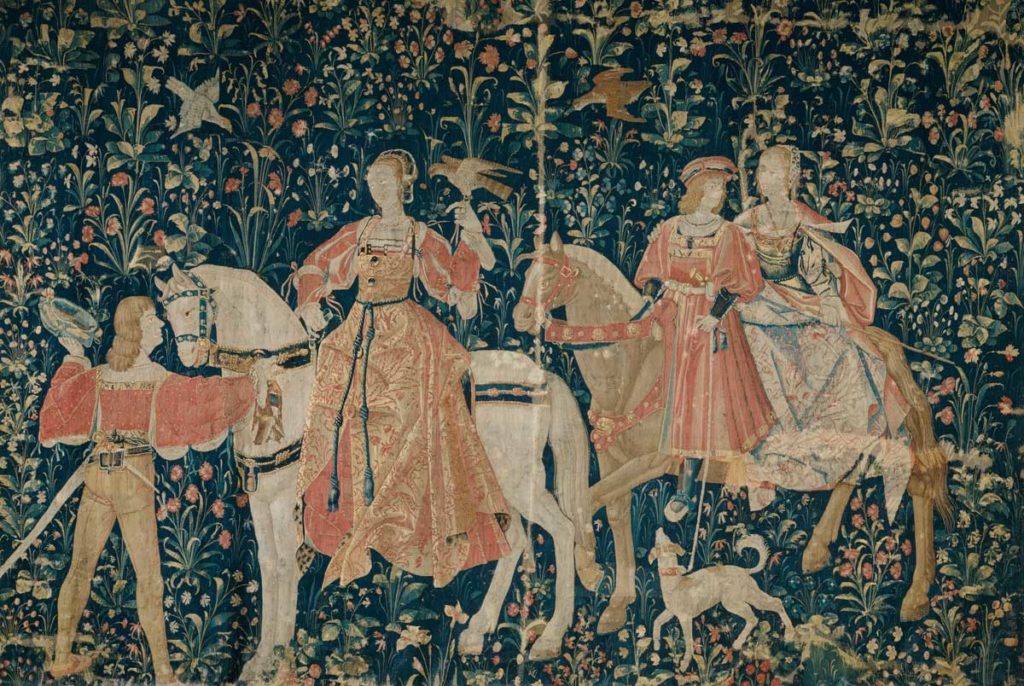
Master of the Hounds was a coveted position in the royal court, as they were responsible for providing well-trained animals for a hunting party. It may seem a small duty to be given such praise, but quality hounds were often presented as gifts to foreign royalty or favored nobility, and so the position had a strong political undertone. The presentation of deer droppings to the queen was considered an honor, as it meant the hounds had done good work and therefore the master must be excellent at his job.
Companion Dogs
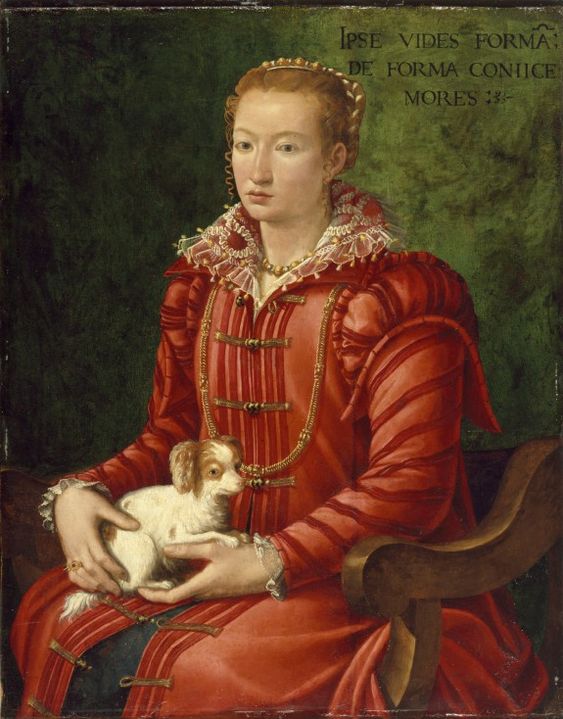
Lapdogs were a popular favorite among courtiers, as the dog was small enough to be unobtrusive and was used for companionship and to keep warm on chilly days. In the medieval era, one could even find lady’s graves with an effigy of their favored companion carved into the stone. Some even believed these dogs to have health benefits for those with weak stomachs. The love of these small dogs was not universal however, as some moralists of the day found them to be “instruments of follie to play and dallie withal” that distracted their owners from their duties and more important thoughts. Nonetheless, the popularity of these toy dogs persisted to such a degree that some would even take their pets to church and on long voyages with them. There were many favored lapdog breeds, though among the most popular were Spaniels.
An Interview with Cirque Lapin
Where to Begin
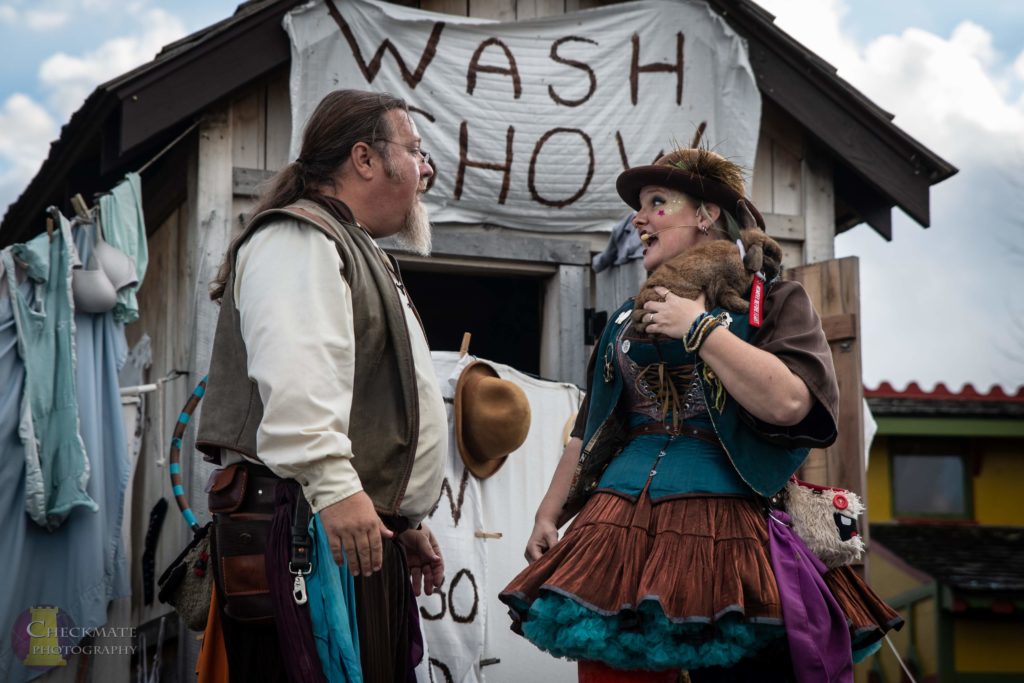
David and I (Felix), are both Ohio natives and this is our home festival, we met here while working at a booth in 2005. A few seasons later, we started performing as a way to increase interest in Dave’s booth which sold magic tricks and juggling equipment. We love the people here and really enjoy seeing faces year after year. It being close to our home is a bonus! We’re really excited to be part of the amazing growth here and the team is a really incredible group of people. And everyone here likes my dogs. That’s a plus.
We always knew the show should lean into the comedic side of magic. The idea of a bumbling magician who surprises even himself was something we played with from the beginning. Incorporating animals happened somewhat organically, as I tend to collect misfit creatures. We started with chickens and even had a snake in the show at one point! When BearBear came into our lives, the “Cirque” theme really started to blossom. We both enjoyed the idea of a variety show that keeps the crowd engaged with multiple elements. At first, I just helped in a silent capacity- lovely assistant style. I wasn’t comfortable being onstage or even speaking in front of people! Dave was a natural, he made it seem effortless. It took me almost that first entire season to get comfortable enough to perform a speaking role. As the show grew and matured, we made the decision to close the booth to focus on performing. Since then, it’s been a matter of training the animals and working to develop routines that flow together and allow for the timing needed to accomplish the illusions.
Building a Show
I think it’s really important to mention here that most of our most memorable material has been developed on stage, in real time. We can write all the jokes in the world, but if they don’t work for the people in the seats- they mean nothing. “Flight time”, or the time spent on stage- in front of a crowd, is invaluable to comedic performance. I think it’s really about presentation. Dave’s character of the bumbling magician who is full of surprises is a delight to watch. Often, folks’s memory of what they saw in the show is through the lens of how the show made them feel. The innocence of the character comes through in the performance.
One of the biggest challenges to performing in such a bustling space. We try to make sure the show is visually appealing and that we can be heard by the crowd. If we can make them smile in the line for turkey legs, they’ll probably come sit down. The finale was the biggest challenge for us as it had been done poorly on television shortly after we started working on it. So we had to ask ourselves, “If magic was real, how would we do this?” We had never seen a performer do it with the presentation we decided to try. Then it was a matter of engineering the illusion backwards to make it possible and safe.
In the mundane world, I have worked in veterinary medicine for the better part of the last 20 years. Working in veterinary medicine has provided me with a lot of hands-on learning about animal behavior and training. Dave and I do a lot of research regarding training methods. The primary training method we use is called “shaping” and it relies heavily on the animal’s natural behaviors as well as marking and rewarding those behaviors and actions at the correct time.
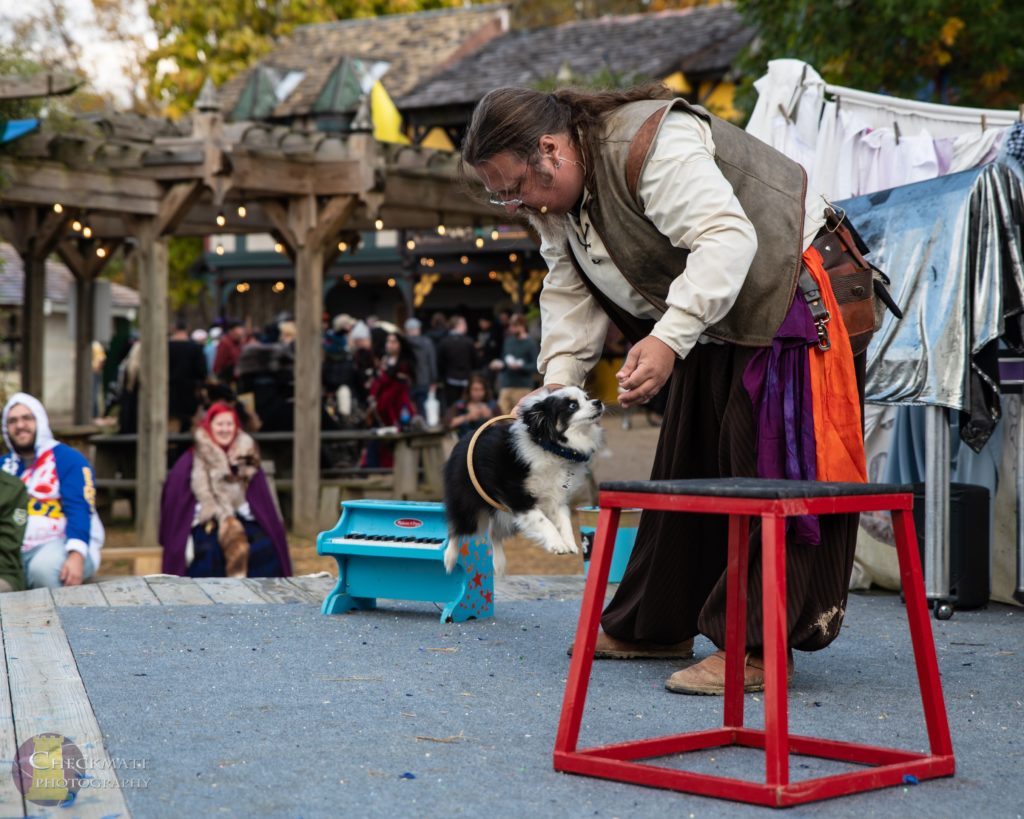
The most important aspect of their training is socialization. They need to be comfortable with all kinds of people, sights, and sounds. Learning tricks is secondary to them being good citizens when they are working. I can’t really answer how long it takes to train a dog because training is an ongoing process throughout the dog’s entire life. Every day is training. Every “good boy”, every treat, every meal, even every performance. Every interaction the dog has with the world shapes how they behave.
In regards to what we do when they are no longer able to perform or aren’t suited for performance, they retire or go on a “sabbatical”. They remain loved and spoiled rotten family members, they just get to stay home in the air conditioning! As I mentioned before, I tend to accumulate misfit creatures. In the mundane world, I have worked in veterinary medicine for the better part of the last 20 years.
For the Love of Fluff
BearBear was surrendered to me at nine years old due to him being “challenging” and “difficult to control”. I know, I don’t believe it either. In all seriousness, he had some medical issues that needed to be addressed and it did take about a year of immersive training for him to become the lovable, fluffy cloud we all know and love. He took to performing and even to “meet and greet” like a fish to water.
The summer BearBear made his debut, it was clear that there was no turning back. We were a “dog show”. But he was not a young dog, and performing can be as taxing on an animal as it can for their human counterparts, especially in the hot sun or freezing rain. We began to look for a successor for our fluffy white cloud. We wanted a dog that would be intelligent enough to learn tricks quickly, athletic enough to perform jumps, and tolerant of the heat. Oz, the Australian Cattle Dog (AKA Red Heeler), seemed the obvious choice.
Oz picked up skills quickly, but he was not super thrilled about audience members being in his bubble. When an acquaintance reached out for help homing a highly social young dog, we were interested. Not only for the show but for our little furry family. While Oz played well with our other senior dog, Lupin, he was often too rough for BearBear. When we met Pip, that was really all it took. His effervescent personality and whip-smart intelligence made him a great fit for the pack and for the show.
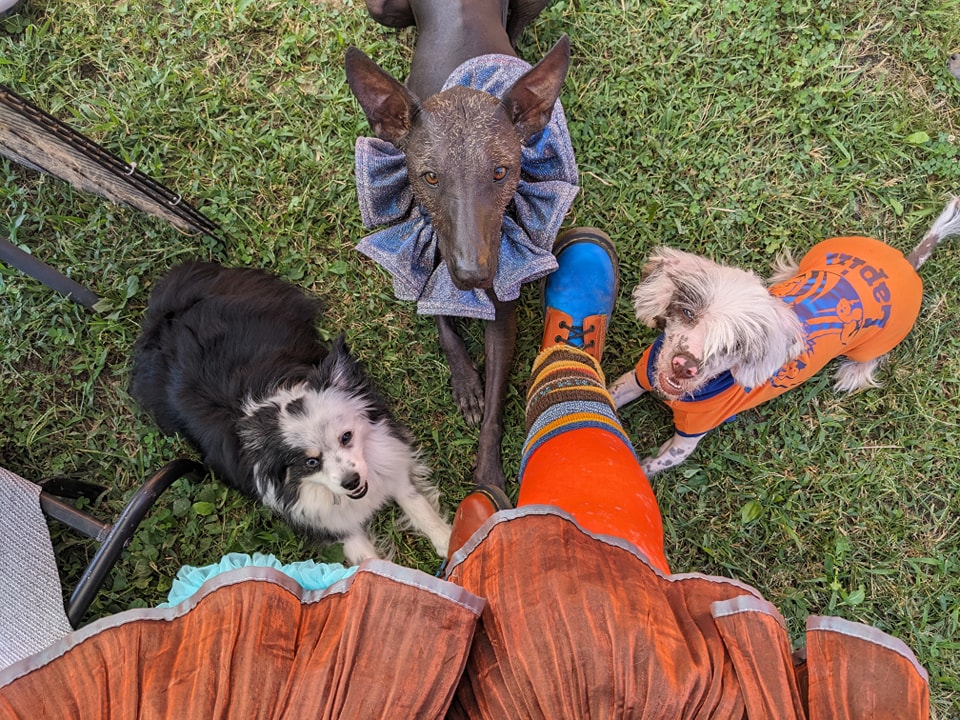
We were not looking for another dog when a coworker showed me Icca’s listing on an adoption site. Xoloitzcuintlis are among the rarest dogs in the world. He was a once-in-a-lifetime find. We took Oz, who is the “bully” of the pack, to meet him at a local park and they didn’t hate each other so we said yes. Icca is definitely our greatest training challenge; he is easily overstimulated and *whispering* not very smart. But he sure is pretty.
Which brings us to Grendel. In the fall of 2021, BearBear became very ill. His epilepsy was not well controlled and he began having serious mobility problems. It truly looked like the end was approaching fast. And so I adopted a puppy, to learn from my heart dog. The first dog I had chosen for myself- pick of the litter! …and then BearBear miraculously got better.
The bunnies’ story is kind of similar. I adopted a rabbit and then rescued several from being culled (killed) and then took another, and another, etc. Moe Bunny is from a breeder due to her needing to fit in the cannon!
The Festival Life
We both really enjoy getting to see folks year after year and share our wonderful little family with them. It’s a joy to see folks light up when they see little Pip playing the piano or the look of surprise when, even for an instant, magic is real. I would urge anyone thinking of pursuing a career within the festival circuit to hold on to the magic of the faire and believe in your own worth
Several years ago, we did a bit with some fire. Dave’s line was, “Everyone loves a hot wench!” and a fireball would appear to come from my head (but was a safe distance). On one very damp morning, the fireball was a little early, and wrapped around the back of my head, singeing my hat and my hair. Dave -froze-. The audience -froze-. I looked at Dave and said, “You caught my head on fire, didn’t you?” He just nodded with a huge red-faced grin. That was a good show.
Another instance occurred just a few years ago here at the Ohio Renaissance Festival. On “Trick-or-Treat” weekend, during one of our meet-and-greets after a show, a patron put one of those little mylar crowns (like for a child’s party) on BearBear’s head and he came trotting back over to me with the biggest smile! It was just the sweetest interaction.
Going Forward
BearBear is truly retired as of the close of the 2022 season he has some cognitive challenges that come with age (he’s 14!) and the heat isn’t safe for him anymore. While we would love to add another dog or another animal to the show, we have to remember that even our retired costars live in our home. Their care is a multi-year commitment, regardless of their performing status. We have a total of six dogs in addition to multiple rabbits and cats (and a perpetually grumpy parrot) at home. At this point, it’s not feasible to add any more to our furry family. That said, I imagine within five or ten years the cast of Cirque Lapin will grow and change.
Oz is on “sabbatical”- he is too stressed on stage to enjoy himself and his hypervigilance even seeps into his time backstage away from the public. He may return; we are working to rebuild his confidence and reduce his stressors. But if he doesn’t enjoy performing, he absolutely doesn’t have to do it!
